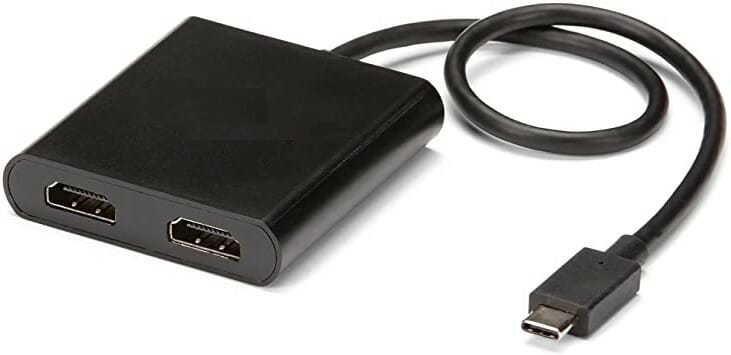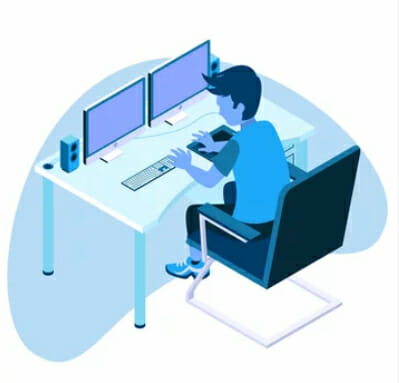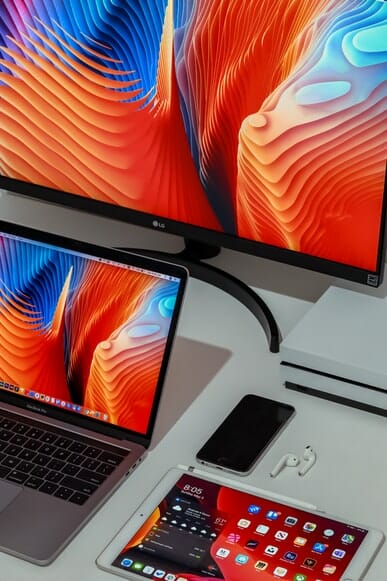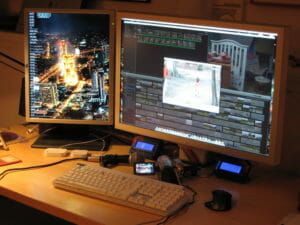Table of Contents
Do you use dual monitors setup at home, work, or for other computer-related activities? Do you feel like duplicating the output of your devices?
It can be challenging getting things done on one monitor. As such, you may want to display your content on multiple HDMI devices instead of one. For instance, you may want to display something on dual monitors i.e. your monitor and other televisions in the room. Additionally, you may want to display something from your computer to a projector and a TV.
Key Takeaways
- A HDMI Splitter will split the signal from a single source device to facilitate simultaneous connection to multiple displays.
- HDMI splitters can send a single video signal to two HDMI monitors at the same time.
- If you want to display content through multiple screens or multiple TVs, then a HDMI splitter with multiple inputs is recommended.
- Unlike HDMI splitter that accept one source, HDMI switch takes more one than source, and sends it to one device via the cable output.
Splitting the contents doesn't have to be a scary affair. All you need is an HDMI splitter for dual monitors. In this guide, we'll take you through how to use an HDMI splitter to connect dual monitors.
How Does an HDMI Splitter Work for Dual Monitors?
An HDMI splitter will help you duplicate the picture from the original device to other HDMI devices in the room. But what is an HDMI splitter?
What Is an HDMI Splitter?
HDMI splitters are devices that help in splitting pictures. For instance, you can use an HDMI splitter to display the same picture from your laptop to the TVs in your room and a projector.

Many users will confuse an HDMI splitter with an HDMI adapter or switch.
An HDMI adapter helps in duplicating and extending your pictures. It allows you to extend the picture to different monitors. The adapter comes with 2 HDMI ports for each monitor at one end. On the other end is a USB power cable or USB-C cable.
Additionally, an HDMI switch helps when you want to hook various devices to one port. The device comes in handy if you don't have several HDMI ports on your device. It enables you to play what you want by switching between various HDMI inputs.
How Can You Use an HDMI Splitter?
Using an HDMI splitter to set up dual monitors is as simple as plugging it in, setting it in a discreet place, and you are good to go.
Assuming you have a game console or cable box in your room. The device has a single HDMI port that outputs videos. Assuming you have a TV, a projector, or multiple displays in your room. How do you ensure the two devices get the HDMI signal?
You require a 1x2 HDMI splitter and HDMI cable to connect the devices. The game console will plug into your HDMI splitter while the splitter plugs into multiple devices. The devices will receive the same picture with the same resolution and sound quality.
Are Your HDMI Splitters Offering the Best Resolution?
If you aren't receiving the best resolution from your HDMI splitters, the problem could be in your setups. For instance, you can have a device that doesn't match the others in terms of resolutions. One display may support 1080p resolution, while others support the 4k resolution.
The EDID (Extended Display Identification Data) requires the HDMI splitter to send the same signal to multiple displays. If it detects that one display supports 1080p resolution, it'll send the same signal to displays.
You can deal with the issue using an HDMI downscaler. The HDMI downscaler receives a 4k signal and downscales it to 1080p resolution. Thus the HDMI splitter sends the same 4k resolution signal to all the monitors thinking they all support 4k resolution.
Choosing the Best HDMI Splitters
HDMI splitter takes the signal from the source device to the multiple devices in your setup. So, you know you need an HDMI splitter, but how do you ensure you get the best. The best HDMI splitter should ensure you receive the same quality audio and video signals.
Here are factors to consider when looking for an HDMI splitter:
4k or 1080p Resolution Support
If you want your HDMI splitter to display the same signal as the source device, you should ensure it supports the proper resolution.
If your HDMI devices support 4k resolution, ensure that your HDMI splitter is also 4k capable of delivering the same quality signal.
HDMI Version Support
There are multiple HDMI formats in the market which support different features. Before you can settle on an HDMI splitter, ensure it supports your version of HDMI cable.
For instance, the HDMI 2.0 supports 4k ultra HD video resolutions, while HDMI 1.4 supports Audio Return Channel (ARC).
HDCP License/ EDID Handshaking
When the HDMI splitter connects using HDCP, it'll send signals to the devices in your setup to find out the data it can support. Thus, the system will operate faster.
All the devices in your setup, including the HDMI splitter, need to be HDCP compliant. Additionally, the EDID command requires devices to announce the formats of audio and video that they support.
An HDMI splitter model with an EDID switch will save you the trouble of playing some types of the video signal.
HDMI Splitters That Bypass HDCP
There is a Fallback mode inside HDCP that allows for HDCP-compliant content to "fall back" to a lower resolution (usually 720p) if the equipment isn't HDCP-compliant. Fallback mode rarely gets triggered by devices other than a splitter, which is why they're a great solution to this issue.
Some cheap splitters bypass HDCP entirely by accident. Because cheap splitter manufacturers didn't bother paying for an HDCP license, they shouldn't be able to play protected content at all. However, because they trigger Fallback mode, the content gets downgraded to a lower resolution and plays normally.
Audio Formats
Before you can purchase an HDMI splitter, it'll be best to check the audio formats it supports.
For instance, if you require the splitter to pass a Dolby Atmos Audio to your other devices, ensure it supports the audio format.
HDMI Outputs
You also need to decide the number of devices to split the signal to. The number of HDMI output ports on your splitter depends on how many devices you want to split the signal to.
Note the HDMI splitters become more expensive with more devices connected.
Powered Splitters or Passive
A powered HDMI splitter will require a separate power feed, while a passive splitter doesn't require one. A passive splitter may be more attractive to purchase since it won't use any energy. However, they don't work effectively, and it is likely to bring about latency.
A powered HDMI splitter is more recommended since energy is essential in separating various streams of HDMI.
The best choice between various HDMI splitters will depend on price and quality. You can invest more in an HDMI splitter that offers better quality audio and video formats and is easier to use.

Installing an HDMI Cable Splitter
A splitter is a handy device as it helps you duplicate audio and video formats from a source device to other monitors.
After you purchase a splitter, how do you install it?
A splitter is an effortless and straightforward device to install.
If you have a splitter that you want to install to duplicate images from a laptop to a TV and a projector, you'll require an HDMI cable between the projector and the splitter. Additionally, you'll require a HDMI cable between the TV and the splitter and between the splitter and the projector.
If you are using a powered splitter, you'll need to connect it to a power source to ensure it works well.

With that straightforward setup, your splitter should duplicate the contents from your laptop to the projector and TV.
How Can You Extend Two Monitors Using One HDMI Port?
If you have one HDMI port on your game console, laptop, and cable box, you can still connect two or more monitors.
You can use an HDMI splitter, HDMI adapter, or HDMI switch. An HDMI splitter will help you replicate the contents of your source devices on your two monitors. It will also help maintain the audio and video quality of the game console or laptop output.
An HDMI splitter acts as a mediator device with two or more HDMI input signals. You can only use a splitter to see similar content on the two monitors. It can only duplicate but cannot extend. As such, each screen will not display a different image.
Not all HDMI splitters aren't the same. It would help if you researched before buying one to ensure it can transmit the best quality audio and video formats without glitches.
How Many Ports Can An HDMI Splitter Have?
Most splitters account for only one extra monitor for your laptop or TV. However, you can find splitters with up to ten HDMI ports to extend the display to multiple monitors. In most cases, you will only require the signal for three or fewer screens, which is work that a splitter can easily achieve.
Also, in case your dual monitor is not working, you should go through the settings again. If that doesn't help, make sure the cable connecting your second monitor is secure, or check out if the graphics driver is outdated or corrupted.
Can You Set up Multiple Monitors Using an HDMI Splitter?
As mentioned earlier, you can use a splitter to display the contents from an HDMI device to multiple devices.
If you are using an adapter, you can duplicate the contents and also extend. That means it's possible to display different contents on the multiple monitors in your setup.
However, with a splitter, you can only duplicate the images. For instance, you can have an illustration during a webinar and duplicate it on a projector and TV for all to see. However, you cannot have a different image on the projector and another on the TV.
Is Splitting an HDMI Signal Illegal?
If you plan on illegally copying and distributing the content, yes, it's probably illegal. However, for the purposes of recording yourself playing video games, making legal backups of property you own, and other fair-use applications, it's not illegal.
Final Word on Hdmi Splitters for Dual Monitors
You can use an HDMI splitter for dual monitors to replicate contents from your laptop, game console, or cable box to other monitors. The splitter helps maintain the high resolution and quality audio from the source device.
When looking for the best HDMI splitter to purchase, you should consider various factors to ensure you get the best. For instance, you can choose between a powered or passive splitter. A powered splitter works better as you require energy to split various HDMI streams. It would help if you also considered how many outputs you require. The more devices you need to connect, the more outputs you require on your splitter.
FAQs
1. Are HDMI splitter reducing quality?
HDMI Splitters do not automatically reduce quality because they are copying a digital signal. But using lower quality hardware or a non-powered splitter is less of a guarantee.
2. Can you use multiple HDMI splitters?
Using a single splitter, you can split your HDMI output to display on up to 16 screens or TVs. A splitter can either split into two, three, four, eight, or sixteen screens.
3. Does HDMI splitter require power?
Passive HDMI splitters don't need power, whereas active HDMI splitters do.
4. Do HDMI splitters work both ways?
Once two signals are combined by a splitter hooked up in reverse, the signals cannot be separated by putting them back into another splitter. This will only split the two combined signals in two directions.


